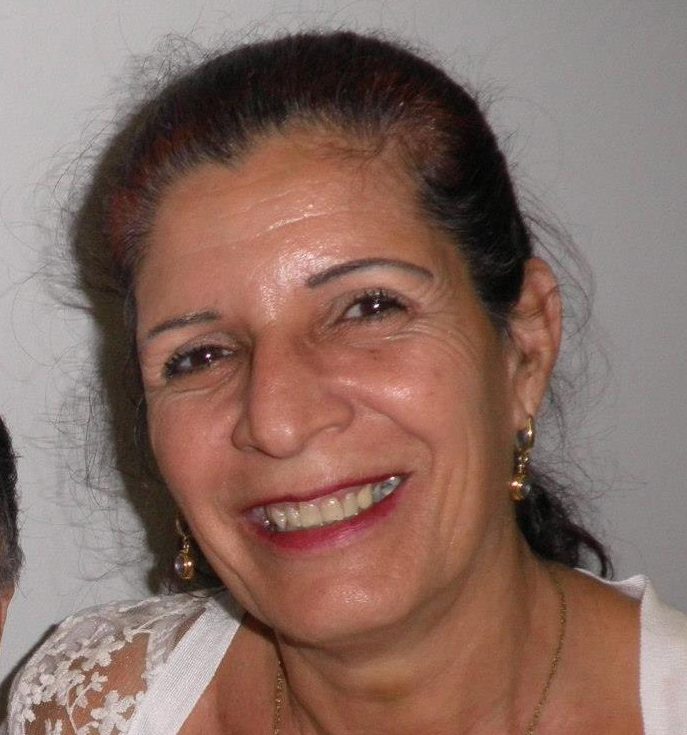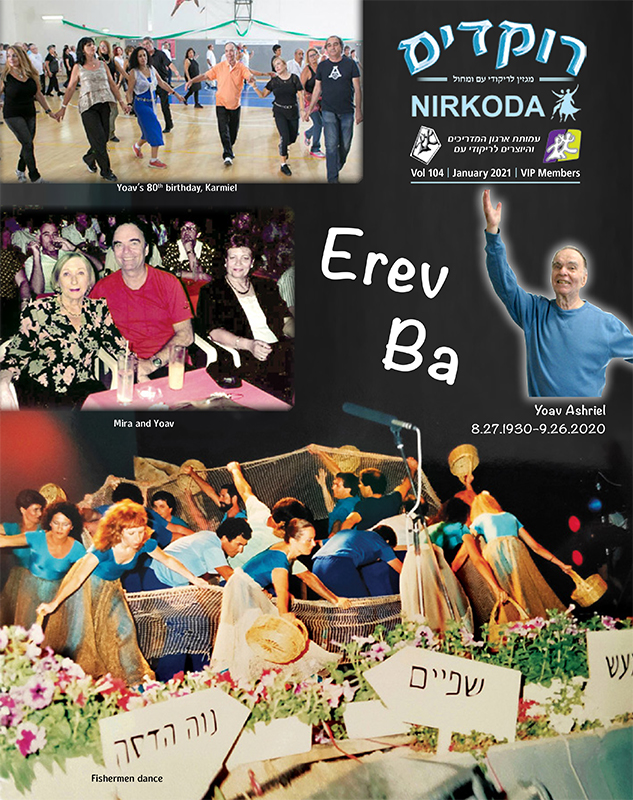- Home
- Rokdim Nirkoda 105
- Demanded Absolute Perfection
When I first heard the name Yoav Ashriel, I was about ten years old. We used to dance Israeli folk dances during breaks at school. Alongside “Hora Medura”, we danced “Debka Daluna” and “Sovevuni”. In the Tzofim – Scout Movement, I also saw our instructors dancing couple dances. I was especially impressed by the dance,”Ez Va’keves”. I was fascinated by the different steps done by the man and woman and the dramatic play between them. I was convinced that this was a dance for the stage. To this day, “Ez Va’keves” is perhaps the only dance in which there is such a dialogue and completely different roles within in it, for male and female.
When I was growing up, I danced at the University. I knew that at the Dubnov School, there was an Israeli folk dance class for advanced dancers, the experts, that was not open to everyone. I remember that once I and looked in through the windows at the Dubnov School. It looked like a completely different world from the dances I knew from the Technion and the University. I felt like I was watching a dance troupe. To me, the dancers looked serious, especially in the beautiful and precise couple dances; they were dressed a little differently, instead of jeans, there were flowing dresses. I felt it was a different league of dancing and I chose not to enter.
Later, I did enter the room. I entered as if it was a solemn temple. Mira, Yoav‘s wife, would look at the dancers with a critical eye, scolding anyone who was inaccurate and who dared to dance in the center and disturb the uniformity and beauty of the circle. I would quietly dance in the outer circle, striving to be precise. I was anxious. We did not approach the dance leaders. There was a distance and hierarchy among the dancers that required everyone to learn, know and reach some coveted and worthy goal of being “advanced”, that is, not to stumble or copy. The feeling was less of dancing and more like rehearsals of a dance troupe in preparation for a performance. It was not easy to fit in. For me, I was still a “dance student” who “one day will arrive”. There was a lot of material to learn. Unlike today, it was clear to all of us that you do not jump the rungs of the ladder, even if you are a top dancer. To this day, I am convinced that those responsible for this approach, which is so lacking today, were Yoav and Mira Ashriel.
I have reached the required level of knowledge! In later years, I danced with Yoav Ashriel regularly at a harkada (dance session) held at the “Amsterdam” Sports Hall in Petah Tikva. This was a wonderful and special harkada that had a unique repertoire of Israeli folk dances that were danced only in this harkada. I’d look forward to it as the high point of the week. During those years, when I was a young mother, I only danced once a week. Who would believe? Once a week; I would wait for it all week …
In those days, rumors began that Yoav was ill, and had undergone a difficult surgery and had stopped leading harkadot. It was not easy to deal with the rumors. We had a large, moving farewell harkada. I remember every moment of it. Dancing and thinking: “What? Really the last time?” There is nothing like Yoav’s harkada. Yes, there were harkadot. But they are different. How good it was that it did not happen. Yoav overcame the illness and returned to us to dance with us for many more years, although the Amsterdam harkada did not return.
Twelve years ago, I began my personal acquaintance with Yoav. It started thanks to my car and thanks to Yudka Ben David. Yudka, a veteran singer in the Campfire Group, danced with Yoav in his youth in a harkada that Gurit Kadman had taught. Both also participated in the “HaPoel Tel Aviv” Folk Dance Troupe and performed at the opening of the Dalia Festival in the dance, “Sherele”.
I was the driver. I would drive Yudka to the Jezreel Valley for various singing performances and Yudka brought his troupe mate, Yoav Ashriel. Along the way, they would tell stories about the troupe and especially the ‘courtships’ within the troupe including the adventures with the women and the performances. The stories were told with such delight that it made me jealous. They were full of youthful joy and laughter.
For those who, like me, are addicted to Israeli folk dance and to the songs of the Land of Israel, their stories sounded like the highs of the fulfillment of their youthful dreams. Love and reciprocity stories, lots of energy and, of course, dance and choreography. I would drive them both with great pride. One of the times when we traveled to the “Adom Atik” harkada in Jerusalem, a short video was made. I like to watch it from time to time and I especially remember the trip to the harkada, more than experience of the harkada itself.
I would also drive Yoav to Hararit, for a veteran dance leaders event that took place every year on Hanukkah at the home of Ruthy Pardess. It was a long drive during which long conversations developed about the world of Israeli folk dance in the past, and where it was heading. Yoav was very attached to the dances of the present and did not long for nostalgia like me and like many members of the nostalgia gang.
There was an attempt to bring back the dance “Tziununei Haderech” to the harkadot. This was a dance by Yoav, that never saw success. Angrily he claimed that its time was over.
I had a conversation with him about his dance to the wonderful song, “Siman She’Ata Tza’ir”. For his part, he had no objection to having another dance choreographed to this song to replace his choreography. He was as honest and critical of his own dances as he was of the dances of others. He was not interested in returning unsuccessful dances to the harkadot.
I would also drive Yoav to various harkadot at which I demonstrated his dances with him. Yoav demanded complete perfection even when he himself had difficulty dancing. “I still have the know-how” he would repeat and criticize mistakes and style.
In 2016, a special tribute evening was held in his honor at the Givatayim Theater.
After the exciting evening, we went out to dance in the theater plaza. Yoav, who was towards the end of his eighties, did not intend to dance, but the Markida (Dance Leader) asked him to demonstrate his dance “T’chol Hamitpachat”. With his eyes, Yoav “checked out” the various female dance leaders who were there and suddenly picked me. I was incredibly surprised; I experienced a “black out” and I tried to evade the invitation, but he insisted. He told me, “With you, I feel at home”. Overall, I felt proud. I told young Orly, the one who peeked through the windows of the Dubnov School, that “She should rejoice in her achievements”.
I was at “Camp Bitnua” in Eilat, where Yoav was invited as Gadi Bitton‘s guest of honor. Dozens of Eilat children came to the camp dressed in white and beautifully performed Yoav Ashriel‘s dances. At the end of their performance, they joined us in the dance circles. These were very exciting moments for all of us. For a moment we experienced the feeling of the beautiful Land of Israel of yesteryear. The one in which we grew up. While Yoav was excited, he kept his excitement in check. Ostensibly, this was a folk dance harkada, thus diminishing his personal part on this occasion.
In recent years, Yoav had conducted a harkada that took place once a month at “Bikurei Ha’Itim” in Tel Aviv. His veteran dancers, those who grew up with him like me, did not give up their presence at this harkada that always “brought” us back to the days of dancing in Petah Tikva and Shefayim. The all-too-unique repertoire was back at its best: Strose To Stroma, España Kani, Jealousy, Red Rose Tango, Blue Tango, Valse Le’Gal, Eretz Tropit Yaffa, and Line Dances: Sugar Sugar, 16 Tons; the list goes on.
Yoav nurtured international folk dances. He was always reminiscent about the past, when he was bored of recycling the small number of dances created in Israel. When he got tired of dependence on the accordion accompaniment, he insisted on introducing Israeli folk dances accompanied by musical recordings (on tape). There was much opposition to this from Gurit Kadman, Tirza Hodes, and Irgun HaMadrichim of the Histadrut (Dance Instructors Union). However, Yoav insisted.
From the distance of years gone by, it turned out he had won big. We have gained the rich world of Israeli folk dance. In this respect, it was clear that his spirit of innovation, going against the flow and adhering to his principles, led to the world of folk dance becoming what it is today, despite the challenging wars he had to fight in the institutionalized folk dance world that existed in the past.
Yoav prepared for this monthly dance session. He carefully prepared a dance list and he would not easily agree to include additional dances in the repertoire. He knew with absolute certainty what was right for him and what was not. Even when a guest choreographer appeared, Yoav would sort their material and not agree to include in his repertoire those dances that he thought the community was unfamiliar with or were less successful in his eyes, even when everyone begged. In his harkadot he was the sole decision maker and he never compromised.
It is difficult to say goodbye to Yoav Ashriel. For someone like me, breathing folk dance from the day I knew what I want, he was and will always be one of the people who influenced my world. Choreographers of the middle generation rose to their prime only after receiving his approval. One after the other, they came as guests to the monthly harkada at “Bikurei Ha’Itim”, all with a different yet similar story, about their first choreography that Yoav corrected, improved, or nixed. A story that was no different from the way he himself used to talk about his dance, “Erev Ba”, and about Gurit Kadman who did not accept it as he had created it.
A generation goes, and a generation comes, and today we have talented young choreographers, yet, there is no figure like Yoav who is a “standard definer” whose stamp of approval can influence the quality of the creations. The face of the world of folk dance is changing and we are flowing with the changes. But it is clear that Yoav‘s “footprint” will always stay with us and influence the spirit of Israeli folk dance.
The eternal “Erev Ba” will not be absent from any harkada in the future, even if, to Yoav’s chagrin, it would be danced in couples. It is our job, as vatikim, to preserve the original version. Let us keep up the spirit of his work and keep longing for someone like him…









Comments
התראות